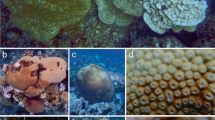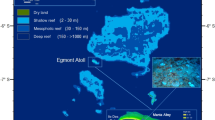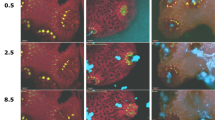Abstract
Environmental stressors such as increased sea surface temperatures are well-known for contributing to coral bleaching; however, the effect of increased temperatures and subsequent bleaching on coral-associated microbial communities is poorly understood. Colonies of the hard coral Acropora millepora were tagged on a reef flat off Magnetic Island (Great Barrier Reef) and surveyed over 2.5 years, which included a severe bleaching event in January/February 2002. Daily average water temperatures exceeded the previous 10-year average by more than 1 °C for extended periods with field-based visual surveys recording all tagged colonies displaying signs of bleaching. During the bleaching period, direct counts of coral zooxanthellae densities decreased by ∼64%, before recovery to pre-bleaching levels after the thermal stress event. A subset of three tagged coral colonies were sampled through the bleaching event and changes in the microbial community elucidated. Denaturing gradient gel electrophoresis (DGGE) analysis demonstrated conserved bacterial banding profiles between the three coral colonies, confirming previous studies highlighting specific microbial associations. As coral colonies bleached, the microbial community shifted and redundancy analysis (RDA) of DGGE banding patterns revealed a correlation of increasing temperature with the appearance of Vibrio-affiliated sequences. Interestingly, this shift to a Vibrio-dominated community commenced prior to visual signs of bleaching. Clone libraries hybridized with Vibrio-specific oligonucleotide probes confirmed an increase in the fraction of Vibrio-affiliated clones during the bleaching period. Post bleaching, the coral microbial associations again shifted, returning to a profile similar to the fingerprints prior to bleaching. This provided further evidence for corals selecting and shaping their microbial partners. For non-bleached samples, a close association with Spongiobacter-related sequences were revealed by both clone libraries and DGGE profiling. Despite Vibrio species being previously implicated in bleaching of specific coral species, it is unsure if the relative increase in retrieved Vibrio sequences is due to bacterial infection or an opportunistic response to compromised health and changing environmental parameters of the coral host. This study provides the first molecular-based study demonstrating changes in coral-associated bacterial assemblages during a bleaching event on a natural reef system.
Similar content being viewed by others
Log in or create a free account to read this content
Gain free access to this article, as well as selected content from this journal and more on nature.com
or
Accession codes
References
Altschul SF, Madden TL, Schaeffer AA, Zhang J, Zhang Z, Miller W et al. (1997). Gapped BLAST and PSI-BLAST: a new generation of protein database search programs. Nucleic Acids Res 25: 3389–3402.
Ben-Haim Y, Rosenberg E . (2002). A novel Vibrio sp. pathogen of the coral Pocillopora damicornis. Mar Biol 141: 47–55.
Ben-Haim Y, Zicherman-Keren M, Rosenberg E . (2003). Temperature-regulated bleaching and lysis of the coral Pocillopora damicornis by the novel pathogen Vibrio coralliilyticus. Appl Environ Microbiol 69: 4236–4242.
Berkelmans R . (2002). Time-integrated thermal bleaching thresholds of reefs and their variation on the Great Barrier Reef. Mar Ecol Prog Ser 229: 73–82.
Berkelmans R, De'ath G, Kinimonth S, Skirving WJ . (2004). A comparison of the 1998 and 2002 coral bleaching events on the Great Barrier Reef: spatial correlation, patterns and predictions. Coral Reefs 23: 74–83.
Berkelmans R, Willis BL . (1999). Seasonal and local spatial patterns in the upper thermal limits of corals on the inshore Central Great Barrier Reef. Coral Reefs 18: 219–228.
Bourne DG, Munn CB . (2005). Diversity of bacteria associated with the coral Pocillopora damicornis from the Great Barrier Reef. Environ Microbiol 7: 1162–1174.
Brown BE . (1997). Coral bleaching: causes and consequences. Coral Reefs 16: S129–S138.
Cooney RP, Pantos O, Le Tissier MDA, Barer MR, O'Donnell AG, Bythell JC . (2002). Characterisation of the bacterial consortium associated with the black band disease in coral using molecular microbiological techniques. Environ Microbiol 4: 401–413.
Downs CA, Mueller E, Phillips S, Fauth JE, Woodley CM . (2000). A molecular biomarker system for assessing the health of coral (Montastrea faveolata) during heat stress. Mar Biotechnol 2: 533–544.
Dunn SR, Bythell JC, Le Tissier MDA, Burnett WJ, Thomason JC . (2002). Programmed cell death and cell necrosis activity during hyperthermic stress-induced bleaching of the symbiotic sea anemone Aiptasia sp. J Exp Mar Biol Ecol 272: 29–53.
Ferris MJ, Muyzer G, Ward DM . (1996). Denaturing gradient gel electrophoresis profiles of 16S rRNA-defined populations inhabiting a hot spring microbial mat community. Appl Environ Microbiol 62: 340–346.
Fisher RA, Corber AS, Williams CB . (1943). The relation between the number of species and the number of individuals in a random sample of an animal population. J Anim Ecol 12: 42–58.
Franklin M, McDonald IR, Bourne DG, Owens NJ, Upstill-Goddard RC, Murrell C . (2005). Bacterial diversity in the bacterioneuston (sea surface microlayer): the bacterioneuston through the looking glass. Environ Microbiol 7: 723–736.
Fraune S, Bosch TC . (2007). Long-term maintenance of species-specific bacterial microbiota in the basal metazoan Hydra. Proc Natl Acad Sci USA 104: 13146–13151.
Frias-Lopez J, Zerkle AL, Bonheyo GT, Fouke BW . (2002). Partitioning of bacterial communities between seawater and healthy, black band diseased and dead coral surfaces. Appl Environ Microbiol 68: 2214–2228.
Ghosh S, Gepstein S, Heikkila JJ, Dumbroff EB . (1988). Use of a scanning densitometer or an ELISA plate reader for measurements of nanogram amounts of protein in crude extracts from biological tissues. Anal Biochem 169: 227–233.
Gil-Agudelo DL, Myers C, Smith GW, Kim K . (2006). Changes in microbial communities associated with Gorgonia ventalina during aspergillosis infection. Dis Aquat Organ 69: 89–94.
Giuliano L, De Domenico M, De Domenico E, Hofle MG, Yakimov MM . (1999). Identification of culturable oligotrophic bacteria within naturally occurring bacterioplankton communities of the Ligurian Sea by 16S rRNA sequencing and probing. Microb Ecol 37: 77–85.
Glynn PW . (1991). Elimination of two reef building hydrocorals following the 1982–1983 El-Nino warming event. Science 253: 69–71.
Good IJ . (1953). The population frequencies of species and the estimation to the population parameters. Biometrika 40: 237–264.
Heck Jr KL, Van Belle G, Simberloff D . (1975). Explicit calculation of the rarefaction diversity measurements and the determination of sufficient sample size. Ecology 56: 1459–1461.
Hoegh-Guldberg O . (1999). Climate change, coral bleaching and the future of the world's coral reefs. Mar Freshw Res 50: 839–866.
Hoegh-Guldberg O . (2004a). Coral reefs and projections of future change. In: Rosenberg E, Loya Y (eds). Coral Health and Disease. Springer-Verlag: Berlin, pp 463–484.
Hoegh-Guldberg O . (2004b). Coral reefs in a century of rapid environmental change. Symbiosis 37: 1–31.
Hold GL, Smith EA, Rappe MS, Maas EW, Moore ERB, Stroempl C et al. (2001). Characterization of bacterial communities associated with toxic and non-toxic dinoflagellates: Alexandrium spp. and Scrippsiella trochoidea. FEMS Microbiol Ecol 37: 161–173.
Holland SH . (1988). A RarefactWin program, version 1.2. (URL Document) http://www.uga.edu/strata/Software.html.
Hurlbert SH . (1971). The non-concept of species diversity: a critique and alternative parameters. Ecology 52: 577–586.
Jokiel PL, Brown EK . (2005). Global warming, regional trends and inshore environmental conditions influence coral bleaching in Hawaii. Glob Change Biol 10: 1627–1641.
Jones RJ, Hoegh-Guldberg O, Larkum AWD, Schreiber U . (1998). Temperature-induced bleaching of corals begins with impairment of the CO2 fixation mechanism in zooxanthellae. Plant Cell Physiol 21: 1219–1230.
Jongman R, Ter Braak C, van Tongeren O . (1995). Data Analysis in Community and Landscape Ecology. Cambridge University Press: Cambridge.
Klaus JS, Janse I, Heikoop JM, Sanford RA, Fouke BW . (2007). Coral microbial communities, zooxanthellae and mucus along gradients of seawater and coastal pollution. Environ Microbiol 9: 1291–1305.
Knowlton N, Rohwer F . (2003). Multispecies microbial mutualism on coral reefs: the host as a habitat. Am Nat 162 (Suppl): S51–S62.
Koh EGL . (1997). Do scleractinian corals engage in chemical warfare against microbes? J Chem Ecol 22: 379–398.
Kühl M, Cohen Y, Dalsgaard T, Jorgensen BB, Revsbech NP . (1995). Microenvironment and photosynthesis of zooxanthellae in scleractinian corals studied with microsensors for O2, pH and light. Mar Ecol Prog Ser 117: 159–172.
Kushmaro A, Loya Y, Fine M, Rosenberg E . (1996). Bacterial infection and coral bleaching. Nature 380: 396.
Kushmaro A, Rosenberg E, Fine M, Ben-Haim Y, Loya Y . (1998). Effect of temperature on bleaching of the coral Oculina patagonica by Vibrio shiloi AK-1. Mar Ecol Prog Ser 171: 131–137.
Kushmaro A, Rosenberg E, Fine M, Loya Y . (1997). Bleaching of the coral Oculina patagonica by Vibrio AK-1. Mar Ecol Prog Ser 147: 159–165.
Lane DJ . (1991). 16S/23S rRNA Sequencing. John Wiley and Sons: Chichester, pp 177–203.
Lesser MP . (1997). Oxidative stress causes coral bleaching during exposure to elevated temperatures. Coral Reefs 16: 187–192.
Loya Y, Sakai K, Yamazato K, Nakano Y, Sembali H, van Woesik R . (2001). Coral bleaching: the winners and losers. Ecol Lett 4: 122–131.
Magurran AE . (1988). Ecological Diversity and its Measurement. Princeton University Press: Princeton, NJ.
Maidak BL, Olsen GJ, Larsen N, Overbeek R, McCaughey MJ, Woese CR . (1996). The Ribosomal Database Project (RDP). Nucleic Acids Res 24: 82–85.
McGrath TA, Smith GW . (1999). In: Cortés JN, Fonseca AC (eds). Proceedings of the 29th Meeting of the Association of Marine Laboratories of the Caribbean, 2000; Cumana, Venezuela. CIMAR, Universidad de Costa Rica: San José, Costa Rica.
Muyzer G, Dewaal EC, Uitterlinden AG . (1993). Profiling of complex microbial populations by denaturing gradient gel electrophoresis analysis of polymerase chain reaction amplified genes coding for the 16S rRNA. Appl Environ Microbiol 59: 695–700.
Pantos O, Cooney RP, Le Tissier MD, Barer MR, O'Donnell AG, Bythell JC . (2003). The bacterial ecology of a plague-like disease affecting the Caribbean coral Montastrea annularis. Environ Microbiol 5: 370–382.
Peters EC, Meyers PA, Yevich PP, Blake NJ . (1981). Bioaccumulation and histopathological effects of oil on a stony coral. Mar Pollut Bull 12: 333–339.
Riley M, Gordon DM . (1999). The ecological role of bacteriocins in bacterial competition. Trends Microbiol 7: 129–133.
Ritchie KB . (2006). Regulation of microbial populations by coral surface mucus and mucus-associated bacteria. Mar Ecol Prog Ser 322: 1–14.
Ritchie KB, Dennis JH, McGrath T, Smith GW . (1994). In: Kass LB (ed). Proceedings of the 5th Symposium of the National History of the Bahamas, vol. 5. Bahamian field station: San Salvador, Bahamas, pp 75–80.
Rohwer F, Breitbart M, Jara J, Azam F, Knowlton N . (2001). Diversity of bacteria associated with the Caribbean coral Montastraea franksi. Coral Reefs 20: 85–91.
Rohwer F, Kelley S . (2004). Culture independent analyses of coral-associated microbes. In: Rosenberg E, Loya Y (eds). Coral Health and Disease. Springer-Verlag, New York, pp 265–277.
Rohwer F, Seguritan V, Azam F, Knowlton N . (2002). Diversity and distribution of coral-associated bacteria. Mar Ecol Prog Ser 243: 1–10.
Rosenberg E . (2004). The bacterial disease hypothesis of coral bleaching. In: Rosenberg E, Loya Y (eds). Coral Health and Disease. Springer-Verlag: New York, pp 445–461.
Rosenberg E, Ben-Haim Y . (2002). Microbial diseases of corals and global warming. Environ Microbiol 4: 318–326.
Rosenberg E, Falkowitz L . (2004). The Vibrio shiloi/Oculina patagonica model system of coral bleaching. Annu Rev Microbiol 58: 143–159.
Rosenberg E, Koren O, Reshef L, Efrony R, Zilber-Rosenberg I . (2007). The role of microorganisms in coral health, disease and evolution. Nat Rev Microbiol 5: 355–362.
Salyers AA, Whitt DD . (1994). Bacterial Pathogenesis: A Molecular Approach. American Society for Microbiology Press: Washington, DC, USA.
Sambrook J, Fritsch EF, Maniatis T . (1989). Molecular Cloning: A laboratory Manual. Cold Spring Harbor Laboratory: Cold Spring Harbor, NY, USA.
Shannon CE, Weaver W . (1963). The Mathematical Theory of Communication. University of Illinois Press: Urbana, IL.
Simberloff D . (1978). Use of rarefaction and related methods in ecology. In: Dickson KL, Cairns JJ, Livingston RJ (eds). Biological Data in Water Pollution Assessment: Quantitative and Statistical Analyses. American Society for Testing and Materials: Philadelphia, PA, pp 150–165.
Stimson J, Kinzie RA . (1991). The temporal pattern and rate of release of zooxanthellae from the reef coral Pocillopora damicornis (Linneaus) under nitrogen-enrichment and control conditions. J Exp Mar Biol Ecol 153: 63–74.
Szmant A, Gassman NJ . (1990). The effects of prolonged bleaching on the tissue biomass and reproduction of the reef coral Montastrea annularis. Coral Reefs 8: 217–224.
Toren A, Landau L, Kushmaro A, Loya Y, Rosenberg E . (1998). Effect of temperature on adhesion of Vibrio strain AK-1 to Oculina patagonica and on coral bleaching. Appl Environ Microbiol 64: 1379–1384.
Acknowledgements
Technical assistance was kindly provided by Marla Kirschbaum and Liz Hambleton. We thank Ray Berkelmans and the Great Barrier Reef (GBRMPA) water-temperature monitoring program for providing temperature data from loggers located on the Nelly Bay reef flat. Lone Høj (AIMS) is thanked for helpful comments during the preparation of this manuscript and Tim Simmonds (AIMS) for help in figure preparation.
Author information
Authors and Affiliations
Corresponding author
Rights and permissions
About this article
Cite this article
Bourne, D., Iida, Y., Uthicke, S. et al. Changes in coral-associated microbial communities during a bleaching event. ISME J 2, 350–363 (2008). https://doi.org/10.1038/ismej.2007.112
Received:
Revised:
Accepted:
Published:
Issue date:
DOI: https://doi.org/10.1038/ismej.2007.112
Keywords
This article is cited by
-
The road forward to incorporate seawater microbes in predictive reef monitoring
Environmental Microbiome (2024)
-
Microbiome changes in Sinularia spp. soft corals relative to health status
Marine Biology (2024)
-
Depth distribution and depth adaptation of microbiomes in juvenile and adult scleractinian corals (Pocillopora verrucosa) in the central South China Sea
Coral Reefs (2024)
-
Microbial community shift on artificial biological reef structures (ABRs) deployed in the South China Sea
Scientific Reports (2023)
-
Microbiomes of a disease-resistant genotype of Acropora cervicornis are resistant to acute, but not chronic, nutrient enrichment
Scientific Reports (2023)



